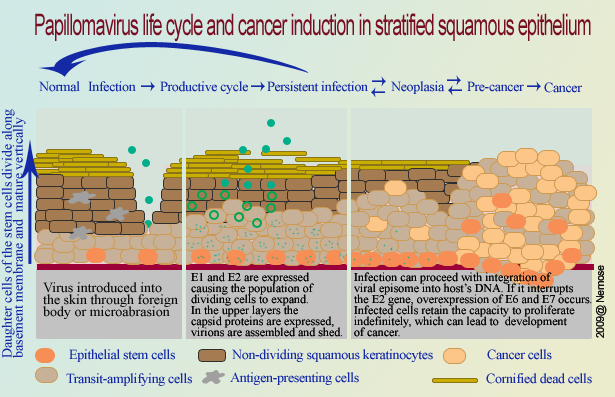Human papillomavirus brief overview
General information
Place among other viruses Short version Full version
Classification based on genotype Short version Full version
Genome Short version Full version
Proteins Short version Full version
Viral life cycle Short version Full version
Mechanism of neoplastic development Short version Full version
Stages of cervical cancer Short version Full version
Vaccination Short version Full version
Taxonomy Short version Full version
References Short version Full version
Human Papillomavirus taxonomic lineage
Viruses - dsDNA viruses, no RNA stage - Papillomaviridae - Human papillomavirus types
General information
Papillomaviruses (PVs) (Papillomaviridae) are small, non-enveloped DNA viruses infecting birds and most mammals including humans.
Papillomaviruses are causative agents of usually benign tumors (warts, papillomas), however, several human papillomavirus types (including types 16, 18, 31, 33, 35, 39, 45, 51, 52, 56, 58, 59 and 66) have been classified as group 1 carcinogens by the International Agency for Research in Cancer (IARC). Among them HPV16 accounts for almost 60% occurrences of cervical cancer, the second largest cause of cancer-related death in women worldwide. Second most important cancer-associated PV is HPV type 18.
Papillomaviruses are absolutely species-specific and extremely tissue-specific. The individual viruses show tropism for either cutaneous or mucosal surfaces usually at specific sites of the body, and, within these groups, they can be separated into high, moderate or low risk types, depending on their oncogenic potential.
Most people in the world are probably infected with at least one if not several types of HPV during their life.
Back to top Nemose
Place among other viruses
In the past PVs and Polyomaviruses were placed in a common family, Papoviridae. In 1980's PVs were separated into their own family Papillomaviridae.
Read more about place of HPV among other viruses
Principles of classification based on genotype
Genera
Species
Types
Subtypes
Variants
Read more about HPV classification principles
Genome structure of HPV
All PVs contain a double-stranded, circular DNA genome approximately 8 kb in size that can be divided into 3 major regions. These regions are separated by two polyadenylation (pA) sites: early pA and late pA.
Long Control Region (LCR)
Early region
Early pA
Late region
Late pA
Read more about HPV genome structure
Human Papillomavirus proteins
Nonstructural proteins
Regulatory proteins
E1 protein
E2 protein
E4 protein
Oncogenes
E5 protein
E6 protein
E7 protein
Structural capsid proteins
L1 protein
L2 protein
Read more about HPV proteins
Back to top Nemose
Human Papillomavirus life cycle
Infection
Viral replication
Replication initiation
Maintenance replication
Vegetative replication
Read more about HPV life cycle
Back to top Nemose
Mechanism of cancer induction
The highest risk of cancer development occurs after prolonged persistent infection. The virus establishes the persistent infection at maintenance replication stage by obviating host's immune responses and, ultimately, integrating its DNA into the host's genome.
More about how Human Papillomavirus causes cancer
